Choosing a dog can be a challenging process. There are dozens of beautiful breeds out there! So, which one do you go for? If you love small dogs, you might pick something like the tiny but feisty Chihuahua, the inquisitive Yorkie, or the easy-going French Bulldog.
For those who prefer medium-to-large dogs, there’s the ever-faithful German Shepherd, the gentle Golden Retriever, and its equally loveable cousin, the Labrador.
Then we have the super-size dogs like the sweet-natured Irish Wolfhound, affectionate Great Pyrenees, or docile but courageous Mastiff!
But what about something a little different? What if there was a mix of two fantastic dog breeds? Something like the Danesky!
What Is A Danesky?
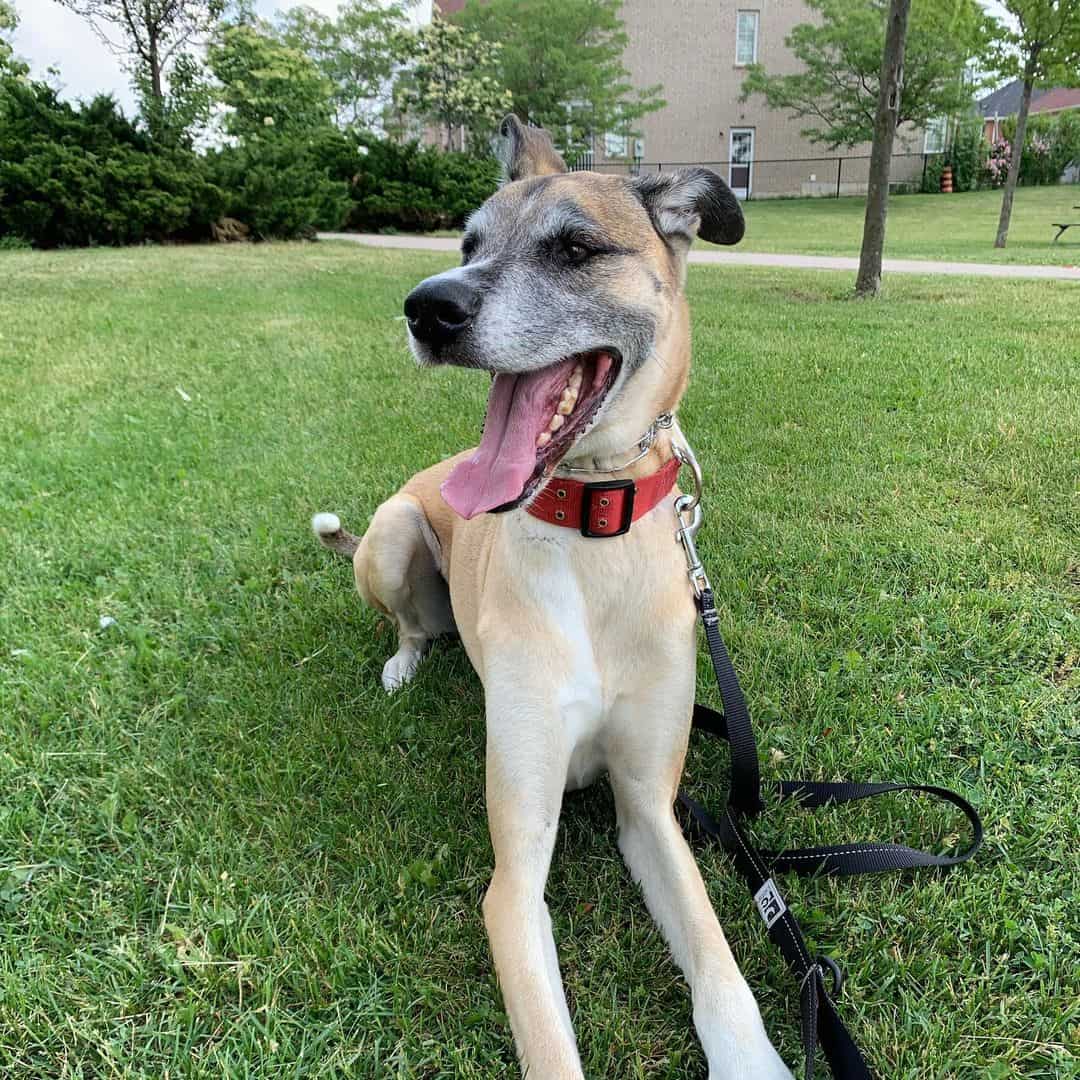
Photo from: @aryathedanemix
This unique dog breed is a cross between a purebred Great Dane and a Siberian Husky. But you already knew this as our title, Great Dane Husky mix, gave it away!
But how much do you know about this mixed breed dog?
We’re diving into the world of hybrid dogs to see what all the fuss is about. By the end, you’ll know if this crossbreed is the dog for you.
First, we’ll examine the parent breeds to see what qualities they might pass onto their hybrid pups.
The Great Dane
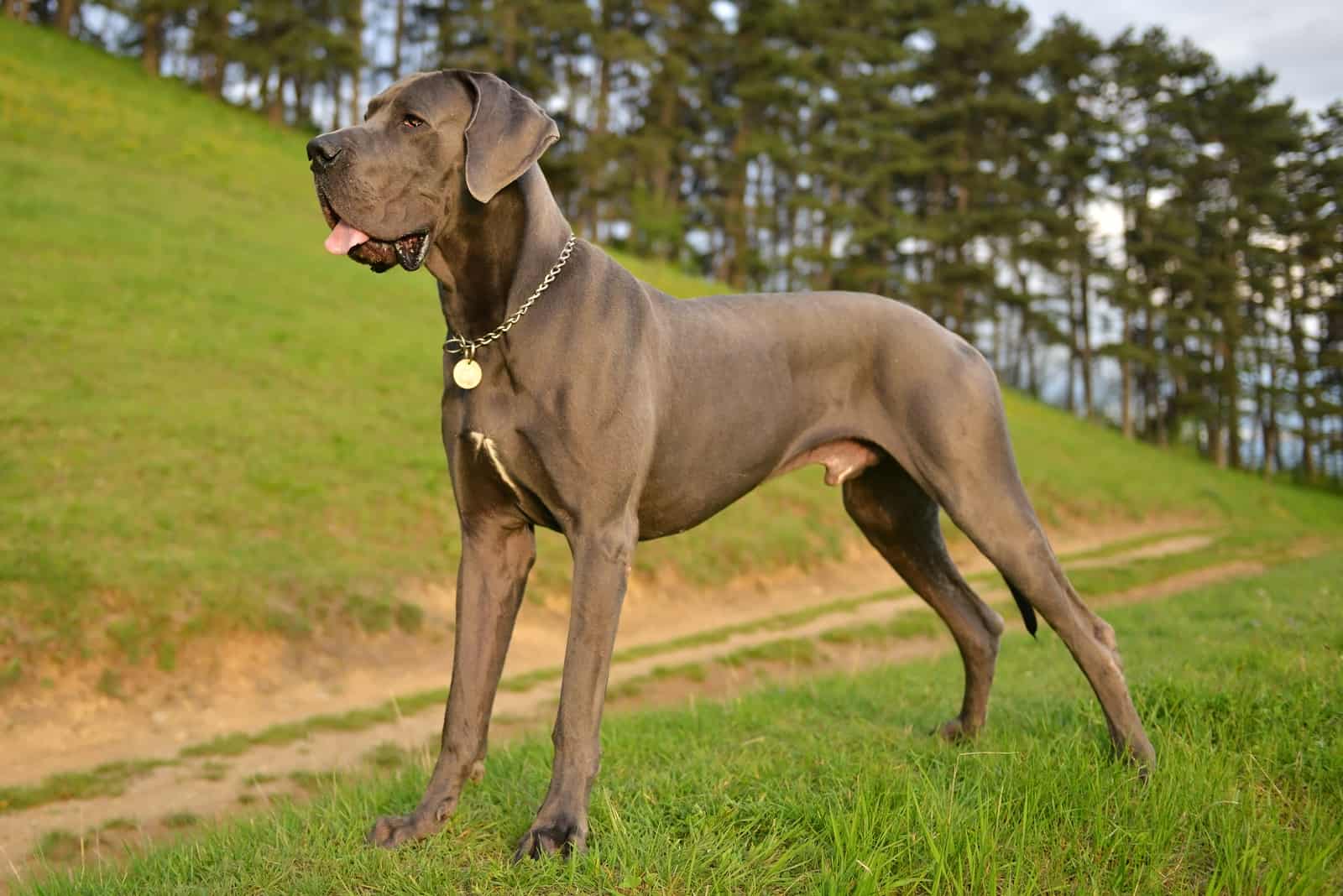
Also called the German Mastiff (because they’re from Germany, not Denmark!), this very large dog breed measures between 28 and 32 inches at the shoulder and weighs between 110 and 175 pounds. You’ll find heavier dogs, but anything over 175 pounds is considered unhealthy.
Originally a working dog used for boar hunting in the 1800s, Great Danes are family pets through and through, forming intensely strong bonds with all family members.
These giant dogs are affectionate and gentle but can be clumsy around kids because of their great size. Although generally calm and quiet, the Great Dane is always alert and protective of its home and family.
Great Danes have a lot of energy for such a big dog, but once they wear themselves out, don’t be surprised if they try to climb on your lap for a cuddle as they have no idea how big they are!
They usually get on pretty well with other dogs (especially after socialization) and tolerate strangers. They might take a few moments but will eventually accept new people if they see you are happy with them being there.
We often imagine the Great Dane as a fawn-colored dog, but there are at least seventeen coat colors to choose from! Ten of these are standard colors, including black, white, blue, merle, and brindle.
This short, smooth coat needs brushing once a week. Although Great Danes don’t shed much, it seems like there’s a lot of hair because they are so big!
The Husky
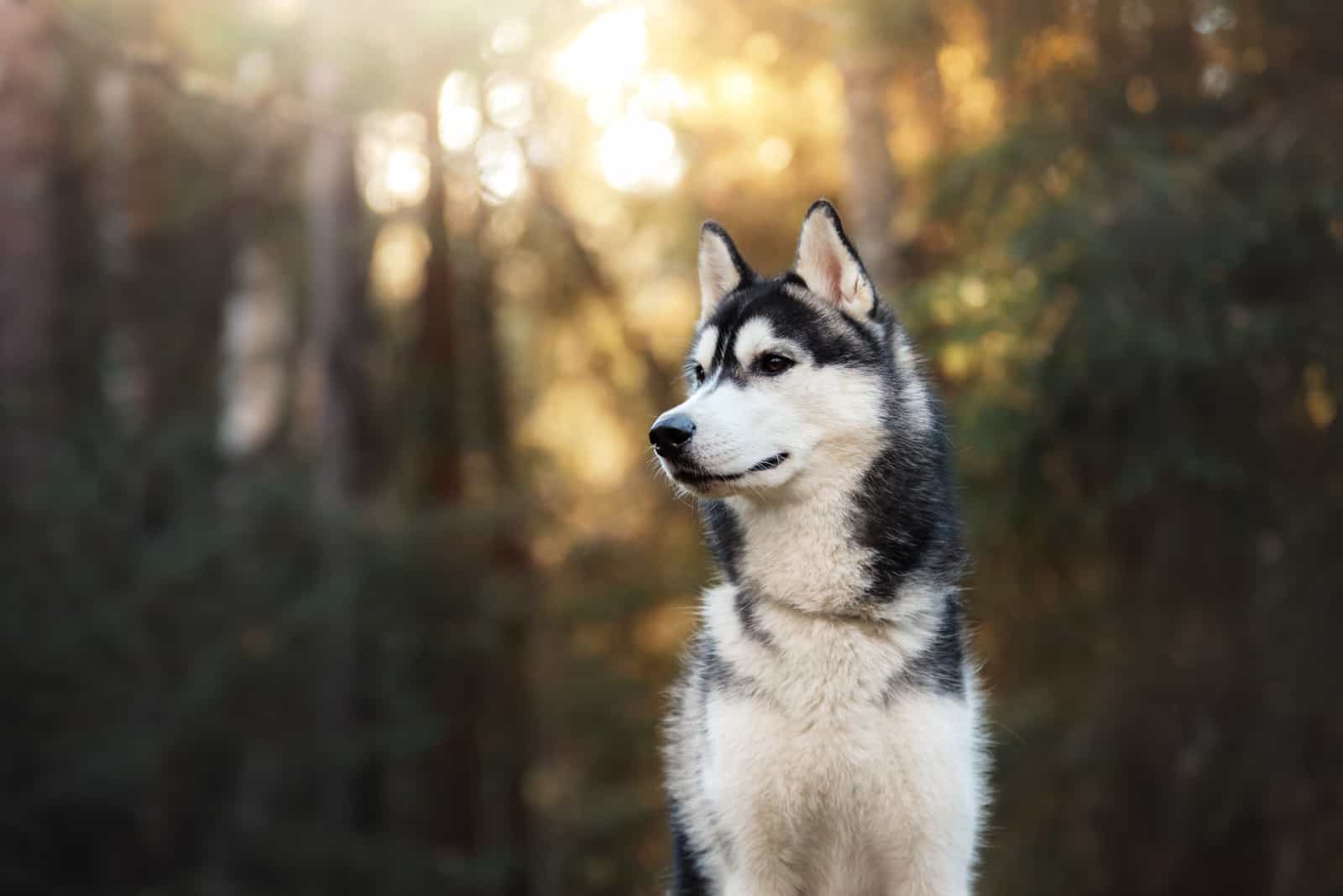
Most Husky owners will confirm that their dogs are just a bit crazy. This breed has a mischievous side that will keep you on your toes! They are endlessly playful and vocal, and they need a pet parent that can cope with their high energy level.
The average Siberian Husky measures between 20 and 23.5 inches at the shoulder and weighs between 35 and 60 pounds, putting them in the medium-size dog category.
These were also initially working dogs (and still are, in some cases) used to pull sleds in the frozen Siberian landscape.
Huskies are usually great with everyone, from total strangers to kids to other dogs, and they want to be everyone’s best friend! Even so, training and socialization are essential if you’re going to keep control of your dog at all times.
The thick Husky coat is ideally adapted to the cold conditions in Siberia, but they can cope with most climates, including the steamy, tropical weather of Southern Florida. They need weekly brushing, but this double coat sheds twice a year heavily, so daily brushing is advisable during these times.
This coat comes in nine standard colors, including black and white, agouti and white, red and white, solid black, and solid white.
If the Husky has a fault, it’s a strong prey drive: they are likely to chase down squirrels, cats, or other small animals.
The Huskies temperament is so highly valued that breeders have crossed it with other dogs to create a fascinating variety of hybrids. These include the Pitbull, Rottweiler, Boxer, Corgi, Malamute, Doberman, and Australian Shepherd Husky mix!
Now let’s see what the Great Dane Siberian Husky mix is all about.
What Does A Great Dane And Husky Mix Look Like?
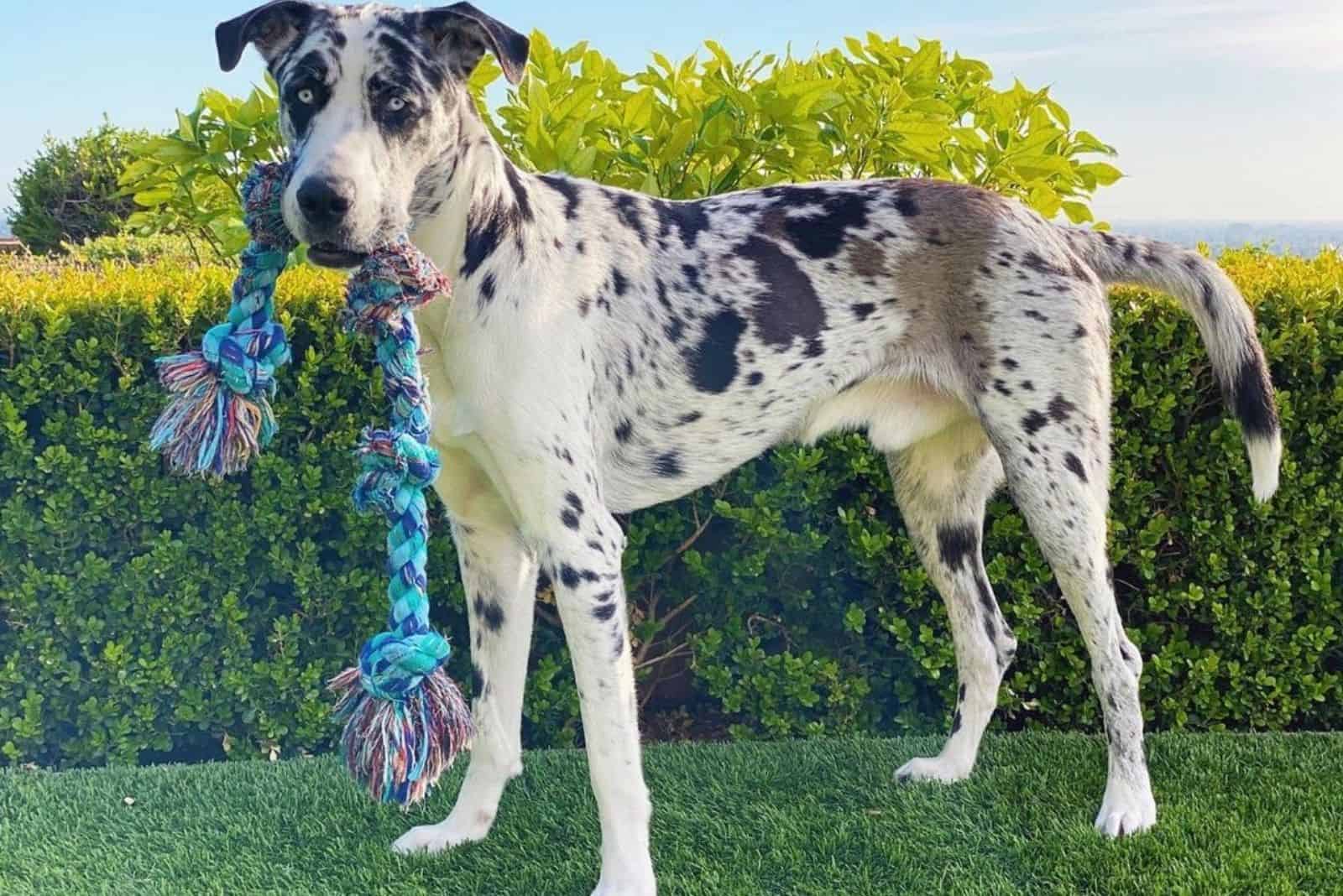
Photo from: @thedaneskies
The exciting thing about mixed breed dogs is that you rarely know what you’re going to get until you get it!
Because of this, it’s not easy to say precisely what a Great Dane and Husky mix will look like. The task is more difficult because kennel clubs don’t recognize mixed breeds, meaning that official records aren’t usually kept.
Even so, we can hazard a guess, as we know the parents pretty well.
The Danesky body shape looks much like the Great Dane rather than the Husky. In most cases, the breeder will mate a male Great Dane with a female Husky to get a 50/50 mix.
However, some breeders have been known to cross 2nd or 3rd generation hybrid dogs with purebred Huskies and Great Danes, so you get more of a 75/25 mix.
How Big Will A Great Dane Husky Mix Get?
As well as having the Great Dane’s body shape, Daneskys usually inherit their size as well. It’s unlikely that you’ll find one under 21 inches, and most will grow much larger. The average size seems to be between 28 and 35 inches!
The dog’s weight should be in proportion to its height, so expect a Danesky to weigh between 90 and 170 pounds.
What Coat Colors Will They Have?
Considering the variety in both breeds, can we expect a similar rainbow of colors in the Great Danesky?
The best we can say is, maybe!
Most examples on websites are fawn, black, black and white, harlequin, brindle, or merle. However, there are likely hundreds of others out there in all sorts of fascinating colors!
It all comes down to the fun of dog coat color genetics. If you want an idea of what color your pup will be, it’s always best to speak to the breeder.
On the subject of colors, your Danesky pup may have blue eyes like the Husky parent.
Great Dane Husky Mix Temperament
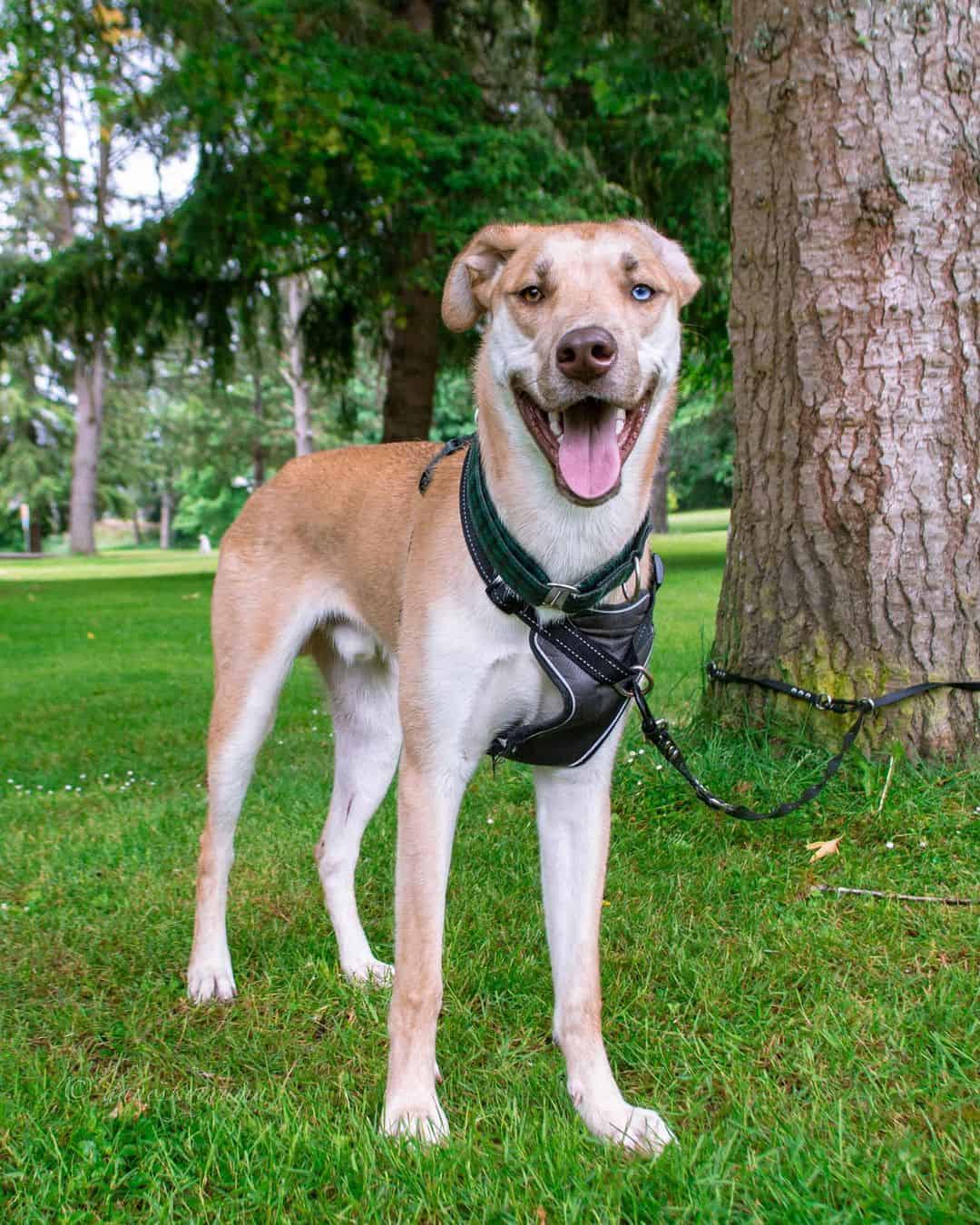
Photo from: @daneskydrama
Both parent dogs have great character and personality, so expect more of the same from your Danesky.
You’ll find that each pup swings more toward one parent than the other, as is the case with all hybrid dogs. However, some stronger traits are often evenly balanced in the puppies.
For example, the famous Husky prey drive could be subdued by the Great Dane’s laid-back nature. Also, the Great Dane’s guard dog instincts may be suppressed slightly. Your dog will still be alert and watchful, maybe even protective, but it will have the Husky’s people-oriented character.
Both parent breeds are known for their willfulness and stubbornness, so training the Great Danesky may be a challenge! Early training should resolve this problem, ideally beginning well before ten weeks of age.
One sure way to get good results is through positive reinforcement. Instead of harsh words and punishment, you reward your pup when it does well, using treats, praise, and petting.
Socialization should also begin early, as this will help reduce the prey drive and produce a well-adjusted adult dog.
Huskies are social animals used to being part of the pack, while Great Danes love human company and don’t like being apart from you. When you combine these issues, you have a recipe for separation anxiety!
The Great Dane Husky mix won’t enjoy being left home alone. Ideally, this is a dog for families where someone is home most of the time.
It’s never a good idea to leave any dog for longer than four hours a day* as they don’t understand what’s happening. Dogs can’t process the passage of time as we do. Their first assumption is that you have abandoned them, so they have a panic attack and destroy your home and your stuff.
While it might look like they had a rowdy party and had a lot of fun doing so, the devastation in your home is a sign of distress.
*Some experts suggest eight hours as the limit, but this applies only to a few select breeds. Most dogs can’t handle more than four hours. If your lifestyle means you won’t be home for long periods and a dog will be left alone for all that time, you should rethink getting one for the dog’s sake.
Finally, the Great Danesky is a gentle giant with a heart of gold, and you’re sure to get plenty of love and affection from this dog. Again, it doesn’t realize its size, so you’ll need to take care of small children are present.
Great Dane Husky Mix Size
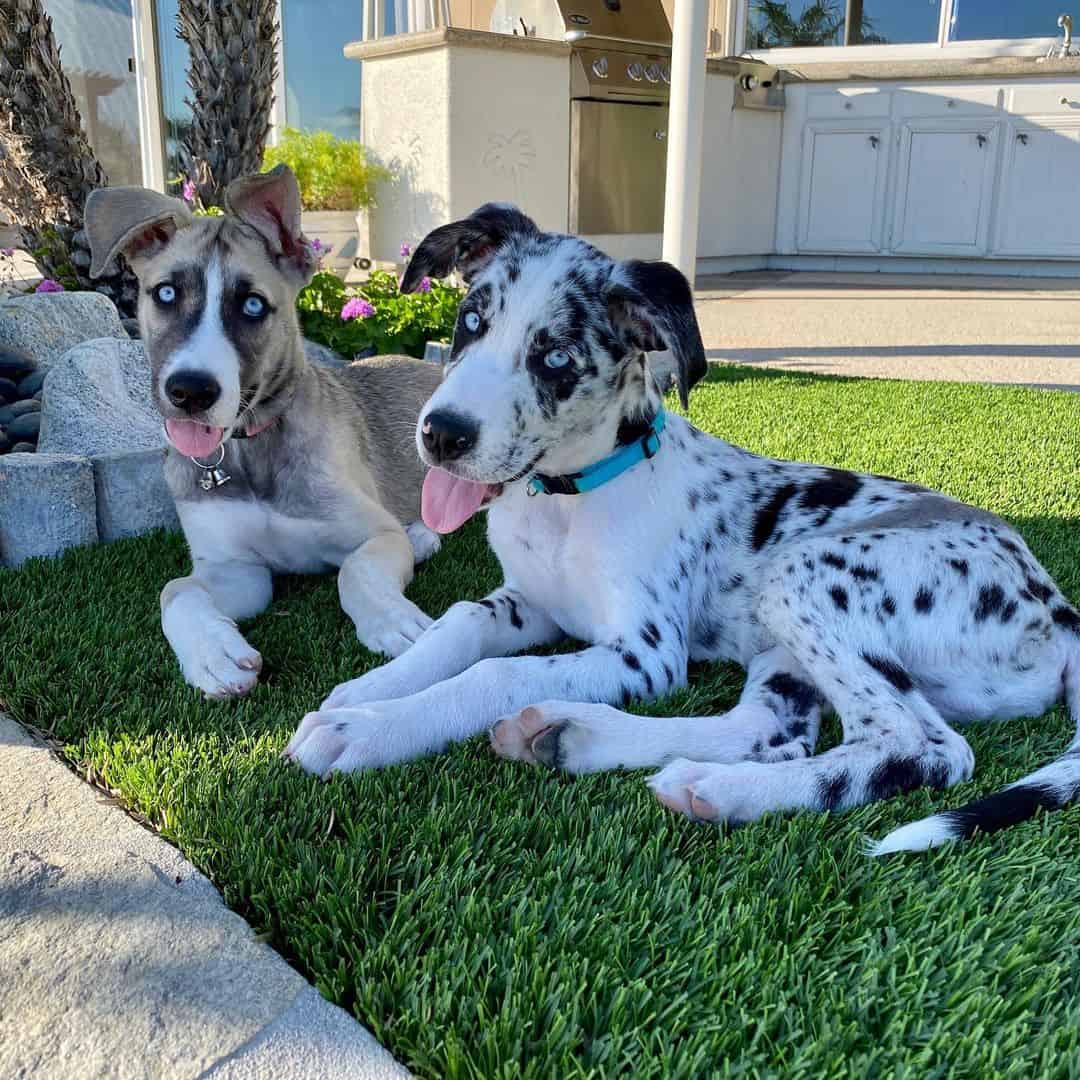
Photo from: @thedaneskies
This is going to be a big dog! On average, a Great Dane Husky mix will grow to between 21 and 35 inches at the shoulder, weighing between 60 and 170 pounds. Most tend to be on the upper end of the scale, especially males.
You’ll need a pretty big house to accommodate the Danesky.
It’s not only about fitting them into your home. It’s also about making sure your dog is comfortable and has room to run and play. It would be best to have a secure yard and some local parks to exercise your dog.
The biggest problem (pun intended!) with the Danesky’s size is food. More accurately, it relates to the size of your dog food budget: big dogs eat a lot, which will cost you far more than if you had, say, a Poodle.
As a comparison, the average Standard Poodle might eat around 2 to 3 cups of food a day, and a Great Dane will get through between 6 and 10 cups.
That’s going to make a sizable dent in your finances over the years, so be prepared!
Great Dane Husky Mix Puppies
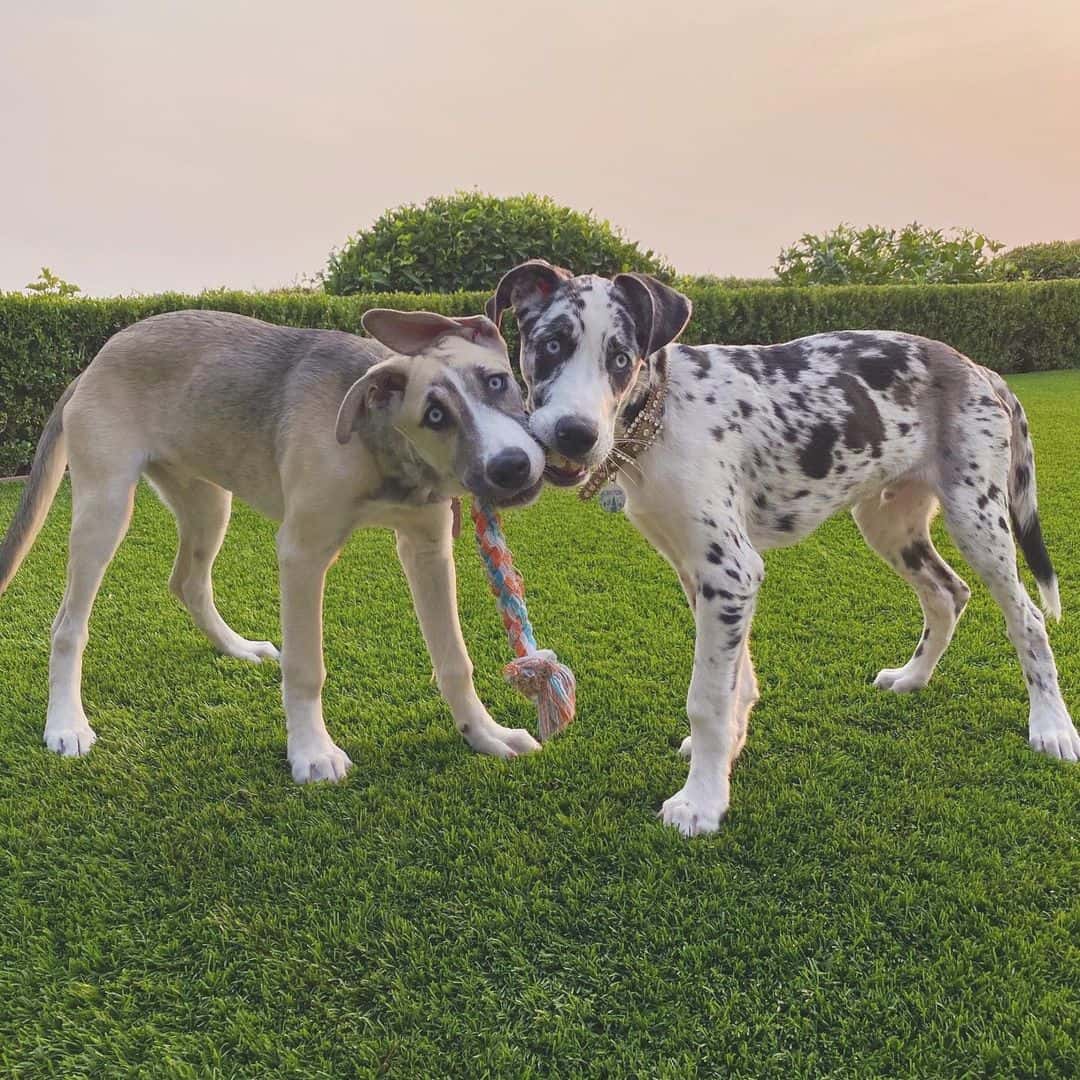
Photo from: @thedaneskies
Puppyhood is a critical time for all dogs, and this is where they are shaped physically and mentally. Your input as their puppy parent is essential, and it’s your job to nurture them, picking up from where their mother left off.
Pups need to be loved, trained, socialized and cared for. They’ll go through several stages, including teething, which could be a trial for you both!
Great Danesky puppies will grow fast, just like their Great Dane parent. It’s vital that they get the nutrition they need and that any exercise isn’t too strenuous, as this will damage their developing muscles and bones.
This is a time to form a strong bond with your pup. Establish regular grooming sessions, as this makes things easier when they are older.
Above all, enjoy this time and take plenty of photos – it will be over before you know it!
Great Dane Husky Mix: Health Issues

Photo from: @daneskydrama
Our precious fur babies are prone to sickness and disease, as all dog owners know.
So, what kind of problems should we look out for in the Danesky? To find out, we must check the parent breeds to see what affects them, as this gives us a good idea of what we might see in their offspring.
Great Dane Health
• Bloat is the number one cause of early death in Great Danes. This condition, also known as gastric torsion, mainly affects big breed dogs with deep chests, and the poor old Great Dane is a prime candidate.
It often happens immediately after the dog has eaten (or drunk) too much, too fast, straight after strenuous exercise. The stomach inflates, twisting around and trapping gas inside. This action also cuts blood flow to vital organs, including the pancreas, which reacts by releasing toxic enzymes that can stop the dog’s heart.
• Hip dysplasia is common in many breeds, but more so in larger dogs. It results from many years of selective breeding, causing dogs to have poorly formed hip joints. This makes the bones rub together, making it painful to walk. Arthritis is common in dogs with hip dysplasia, and surgery is the preferred treatment for severe cases.
• Elbow dysplasia is similar to the above problem, although it can be trickier to fix because the elbow is a more complex joint.
• Wobbler Syndrome is caused by a problem in the neck bones that makes the dog’s back legs weak. This makes them walk strangely, hence the name.
• Eye problems are also common in Great Danes, including glaucoma, entropion, and ectropion. Glaucoma is where the optic nerve is damaged by pressure due to fluid build-up in the eye. Entropion and ectropion are caused by the eyelashes turning inward or outward, making them rub against the eye.
• Cancer is a severe problem for Great Danes, with lymphoma being widespread.
• IMGD, or Inherited Myopathy of Great Danes, is a rare muscle-wasting disease that progresses rapidly, leading to muscle atrophy. It usually appears after the pup is six months old. Only 20% of dogs with this condition survive to adulthood.
Husky Health
Like the Great Dane, the Husky is also at risk of hip dysplasia, cancer, bloat, glaucoma, and other eye problems (including cataracts).
In addition, they are also prone to inherited epilepsy. As there is no apparent cause, it is called idiopathic epilepsy. The best way of eradicating this is by excluding dogs with this condition from breeding programs. However, seizures can be managed with medication.
Now, you might be alarmed by that list of very nasty diseases and health conditions, and that’s understandable.
Even so, there’s some good news: just because they are common, it doesn’t mean that your doggie friend will necessarily have them. Also, these conditions affect the purebred parents. The Danesky is a crossbreed, meaning that the DNA is mixed, and any inherited genetic traits are diluted, lowering the pup’s risk of carrying them.
Finally, if you buy from a respected and reputable breeder, you’ll boost your chances of getting a healthy puppy! All good breeders screen the parent dogs for common genetic conditions and display the results on their websites).
Along with health problems, we should also mention lifespan. This is a significant problem for Great Danes, as they have a life expectancy of between 8 and ten years.
However, the Husky has a better run, between 12 and 15 years. Once again, the benefits of mixed breeding shine through, pushing the Great Dane Husky mix’s average life expectancy to around 12 years. There are reports of these unique dogs reaching 15 years!
Great Dane Husky Mix Price
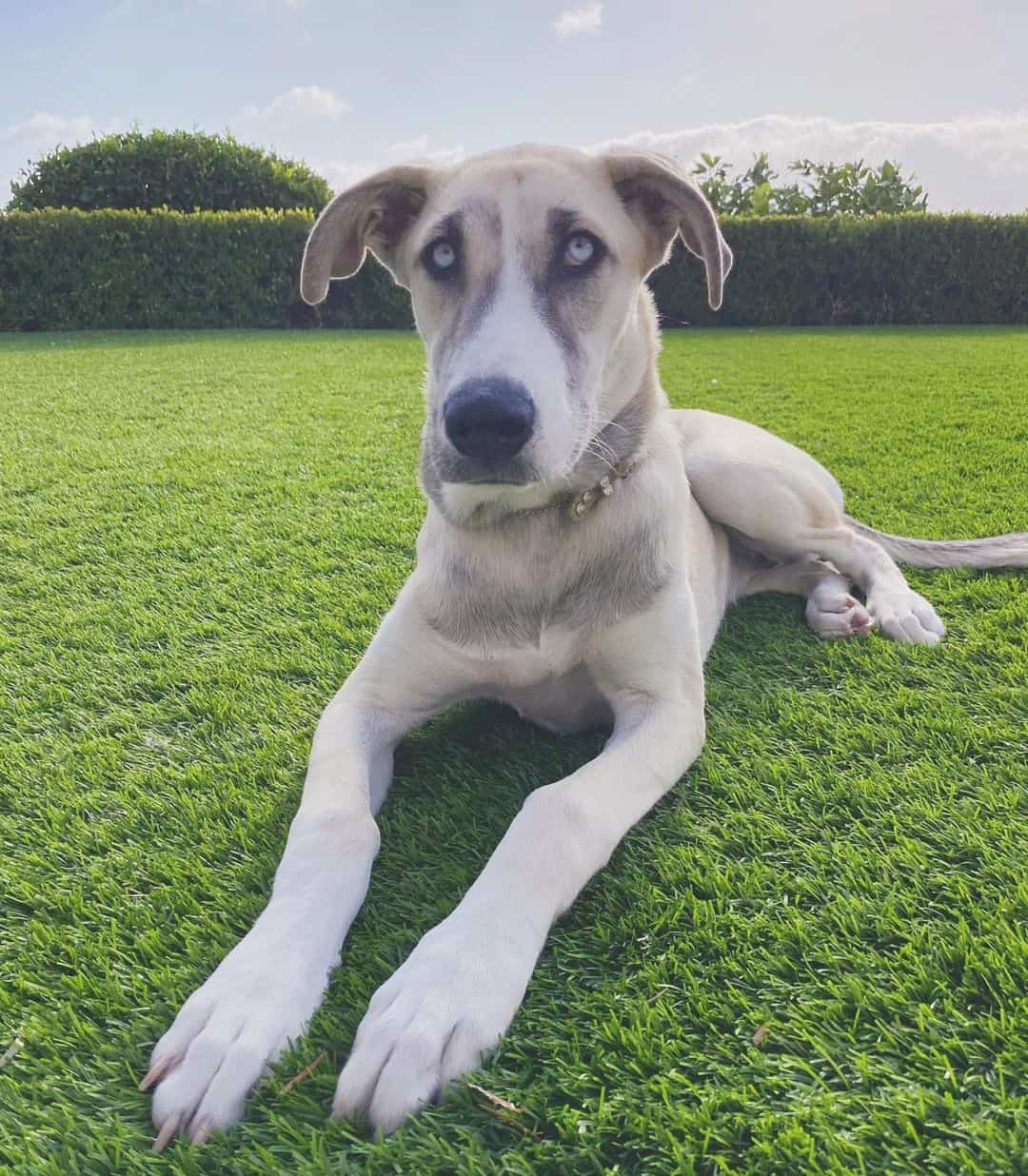
Photo from: @thedaneskies
Although they’re gaining popularity, there aren’t many of these dogs around.
Because of this, they are difficult to find, which can affect the price. However, you should steer clear of breeders who ramp up their prices, claiming that these dogs are ‘rare.’
All the evidence points to a ballpark figure of between $800 to $1,000, although you might pay more if the parents are from excellent bloodlines.
Always remember that you’ll face additional costs on top of your pup’s price. You’ll need to prepare your home ready for the new arrival, as well as pay for things like supplies (bed, crate, blankets, toys, leash, collar, food and water bowls, etc.), vaccinations, and pet insurance.
Many good breeders give you a helping hand by including a puppy starter pack and a few extras, which is always welcome!
In the end, what we’re trying to say is that this is a significant financial investment that you should only go ahead with if you are 100% sure. Giving up a puppy after a few months because it costs more than you thought it would is distressing for all involved, including the pup.
The Great Danesky: Final Thoughts
So, now you know what a Great Dane Husky mix dog is like.
If you love what you see, you might be thinking of getting one for yourself. That’s great, as long as you have considered everything.
It’s not the best dog for first-time owners unless you are prepared for a challenge! The main sticking point is its size. Do you have room for a giant dog? Are you prepared financially, with a budget that includes vet bills and a mountain of food?
Getting any dog is a huge responsibility, and the bigger the dog, the bigger the responsibility!
However, it’s up to you to decide. This is a unique and wonderful dog, so if you are sure, then go ahead!
Read Next: 22 Spectacular Dogs That Look Like Huskies















